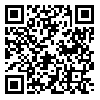Volume 3, Issue 2 (2023)
jpt 2023, 3(2): 121-139 |
Back to browse issues page
Download citation:
BibTeX | RIS | EndNote | Medlars | ProCite | Reference Manager | RefWorks
Send citation to:



BibTeX | RIS | EndNote | Medlars | ProCite | Reference Manager | RefWorks
Send citation to:
Bashiri M, Zakeri M. The Snapshot Model and the Atomic Content of Temporal Experiences. jpt 2023; 3 (2) :121-139
URL: http://jpt.modares.ac.ir/article-34-66454-en.html
URL: http://jpt.modares.ac.ir/article-34-66454-en.html
1- Department of Philosophy and Theology, Faculty of Theology, Farabi Campus, University of Tehran, Qom, Iran
Abstract: (1956 Views)
Temporal experiences are experiences that represent the temporal aspects of the world. Phenomenologically, our temporal experiences directly and immediately belong to temporal properties. This obvious phenomenological truth leads to a paradox with the addition of other premises. Three models have been presented to explain the possibility of direct perceptual experience of temporal properties to solve this paradox. These models are the snapshot or atomic model, extensionalism, and retentionalism. The snapshot model or atomism is that perceptual experiences are only instantaneous or short-term conscious events that occur in succession, and their succession is explanatory and adequate for temporal experience. We will first describe the paradox of temporal experiences and the approach of temporal experience models, try to explain the criticisms of the atomic model and their rejection, and finally show the explanatory adequacy of the succession of atomic experiences for the temporal experience.
Keywords: Temporal Experiences, Snapshot Model, Temporal Properties, Succession, Atomic Content, Co-Consciousness
Article Type: Original Research |
Subject:
Metaphysics (Analytical)
Received: 2022/12/31 | Accepted: 2023/05/26 | Published: 2023/06/19
Received: 2022/12/31 | Accepted: 2023/05/26 | Published: 2023/06/19
References
1. Broad CD (1923). Scientific thought. London: Routledge and Kegan Paul. [Link]
2. Chuard P (2011). Temporal experiences and their parts. Philosophers' Imprint. 11(11):1-28. [Link]
3. Chuard P (2020). Temporal consciousness. Uriah K editor. The Oxford handbook of the philosophy of consciousness. Oxford: Oxford University Press. [Link] [DOI:10.1093/oxfordhb/9780198749677.013.9]
4. Dainton B (2000). Stream of consciousness: Unity and continuity in conscious experience. London: Routledge. [Link]
5. Dainton B (2008a). The experience of time and change. Philosophy Compass. 3(4):619-638. [Link] [DOI:10.1111/j.1747-9991.2008.00153.x]
6. Dainton B (2008b). The phenomenal self. Oxford: Oxford University Press. [Link] [DOI:10.1093/acprof:oso/9780199288847.001.0001]
7. Dainton B (2008c). Sensing change. Philosophical Issues. 18(1):362-384. [Link] [DOI:10.1111/j.1533-6077.2008.00152.x]
8. Dainton B (2017). Temporal consciousness. Stanford: The Stanford Encyclopedia of Philosophy. [Link]
9. Grube E (2014). Atomism and the contents of experience. Journal of Consciousness Studies. 21(7-8):13-33. [Link]
10. Grush R (2007). Time and experience. Müller T editor. The philosophy of time. Frankfurt: Klosterman. p. 27-44. [Link]
11. Grush R (2008). Temporal representation and dynamics. New Ideas in Psychology. 26(2):146-157. [Link] [DOI:10.1016/j.newideapsych.2007.07.017]
12. Holcombe AO (2014). Are there cracks in the façade of continuous visual experience?. Valtteri A, Lloyd D editors. Subjective time: The philosophy, psychology, and neuroscience of temporality. Cambridge: MIT Press. p. 179-198. [Link] [DOI:10.7551/mitpress/8516.003.0015]
13. Husserl E (1991). On the phenomenology of the consciousness of internal time (1893-1917). Brough JB traslator. New York: Springer Science. [Link] [DOI:10.1007/978-94-011-3718-8]
14. James W (1983). The principles of psychology. London: Dover Publications. [Link]
15. Lee G (2014a). Extensionalism, atomism, and continuity. Nathan Oaklander L editor. Debates in the metaphysics of time. London: Bloomsbury Publishing. p. 149-173. [Link] [DOI:10.5040/9781472594112.ch-008]
16. Lee G (2014b). Temporal experience and the temporal structure of experience. Philosophers' Imprint. 14(3). [Link]
17. Miller I (1984). Husserl, perception, and temporal awareness. Cambridge: MIT Press. [Link]
18. O'Callaghan C (2007). Sounds. New York: Oxford University Press. [Link] [DOI:10.1093/acprof:oso/9780199215928.001.0001]
19. O'Callaghan C(2021). Auditory perception. Stanford: The Stanford Encyclopedia of Philosophy. [Link]
20. Phillips I (2011). Indiscriminability and experience of change. The Philosophical Quarterly. 61(245):808-827. [Link] [DOI:10.1111/j.1467-9213.2011.703.x]
21. Plumer G (1985). The myth of the specious present. New York: Oxford University Press. 94(373):19-35. [Link] [DOI:10.1093/mind/XCIV.373.19]
22. Rashbrook-Cooper O (2013). Diachronic and synchronic unity. Philosophical Studies. 164(2):465-484. [Link] [DOI:10.1007/s11098-012-9865-z]
23. Tye M (2003). Consciousness and persons: Unity and identity. Cambridge: MIT Press. [Link] [DOI:10.7551/mitpress/2109.001.0001]
24. Viera GA (2019). The fragmentary model of temporal experience and the mirroring constraint. Philosophical Studies. 176(1):21-44. [Link] [DOI:10.1007/s11098-017-1004-4]
| Rights and permissions | |
 |
This work is licensed under a Creative Commons Attribution-NonCommercial 4.0 International License. |







